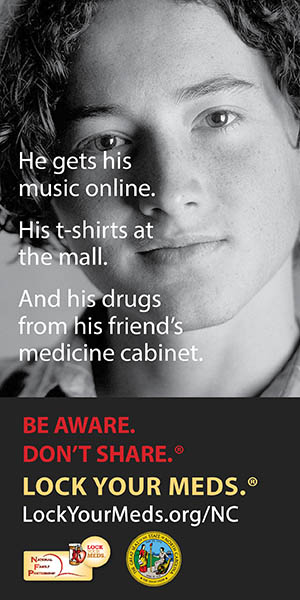
Proper storage of medicine, alcohol, and firearms keeps kids safe.
Rebecca Wenrich Wheeler, MA, MEd, CSAPC – Health Educator
June is National Safety Month, with the focus of reducing injuries at work, in the community, and at home. As summer arrives, youth will spend more time at home and many of those hours unsupervised. Limiting access to medicine, alcohol, and firearms are some of the best ways parents can help prevent injury and death – especially if youth may be home without adult supervision.
Limiting access to these three would significantly decrease overall injury to youth. For instance, 72% of teens who drink say they did not pay for the alcohol, but rather was given the alcohol by a friend or family member, or took it without permission (“Stopping Teens’”, 2018). Imagine the reduction in injury if even a fraction of those youth did not have easy access to alcohol. In terms of firearms, in a 2015 survey 2,800 children and teens died by gunfire; 785 of those deaths were linked to an unlocked firearm (Scutti, 2019). Imagine if those 785 youth did not have easy access to a gun.
In order to reduce the potential of injury or death by medicine, alcohol or firearms, here are some steps parents can take to limit access to these items in the home.
Tips for limiting access to medication:
– Hide and lock medicines, or remove them from the house.
– Monitor quantities of medicine (both prescription and over-the-counter).
– Control access to prescriptions written for youth and monitor refills.
– Educate children about not sharing their prescriptions with friends.
– Properly dispose of medicine at designated drop-off sites and use medicine disposal bags.
– Monitor Internet usage as youth might purchase drugs from illegitimate pharmacy sites. (Lock Your Meds, 2019)
Signs an online pharmacy is not legal:
– Shipping packaging is discreet.
– Pharmacy is outside the US (thus not subject to US safety laws).
– Does not require a prescription to purchase.
– No medical staff listed on website.
– Prices are much lower than in local pharmacies. (“Where do”, 2017)
Tips for preventing access alcohol:
– Ensure youth cannot access alcohol without parents’ knowledge.
– Talk to your children that the expectation is they should not drink.
– Role play refusal skills with your children.
– Talk to parents who host parties, and share your expectations.
– Keep alcohol in a locked cabinet and monitor quantities.
– Consider using a separate locked fridge for chilled alcohol.
– Monitor quantities of any alcohol in the refrigerator and use bottle top locks.
– If any adult in the home misuses illicit drugs or alcohol, seek treatment. (“Stopping Teens’”, 2018)
In addition to limiting access to medicine and alcohol, also learn about the triggers for depression, anxiety, and suicidality among youth, all of which increases the risk of substance use among adolescents (Marcy, 2018). Potential substance use disorders and major depressive disorder share several warning signs: withdrawal from friends, family, and once-loved activities, sudden drop in grades, changes in typical behavior patterns, increased irritability, anger, sadness, and crying, and increase use of alcohol or drugs (Marcy, 2018). Additionally, “There is also a strong correlation between feelings of depression, substance use and gun-related

injuries or deaths” (Marcy, 2018). Research shows that a teen’s decision to complete a suicide is often impulsive and planned in less than 5 minutes (Marcy, 2018). Suicide risk compounds if a youth has been misusing substances, which decreases critical decision making, and has access to a firearm. When a youth is additionally vulnerable due to depressive symptoms, the risk of injury or death due to firearms increases even more. Studies in Seattle showed “that having guns locked up decreases the risk of unintentional shootings and suicides among youth by 75 to 80 percent” (Mann, 2018). Parents should educate themselves on ways to prevent youth gaining access to firearms. Even if your family does not own a firearm, it is still important to discuss firearm safety with youth. Note that a teen shows signs of active substance use disorder or suicide ideation, experts recommend all medicine, drugs, and firearms should be removed from the home (Marcy, 2018).
Tips for preventing access to guns:
– Firearms should be keep locked and out of reach of children and youth.
– Keys to locked cabinets should be kept hidden from children and youth.
– Ammunition should be kept separately.
– If a locked cabinet is not an option, use trigger locks.
– If a child spends time at a friend’s home, ask if firearms are kept locked up, just as you
would ask about medicine and alcohol.
– Role play with your child how to react if they see a gun at a friend’s house. (Marcy, 2017)
Taking just a few simple steps and asking the right questions can prevent injury and even save a youth’s life.
References:
Lock Your Meds Tips.
Require Guns To Be Locked Up.
Keeping Kids Safe from Gun Accidents: 6 Strategies for Families.
Preventing Teen Suicide: When to Remove Firearms from Your Home.
Locking up guns could reduce teen and childhood firearm deaths by a third.
Stopping Teens’ Easy Access to Alcohol.
Where Do Teens Get Drugs.
Featured Poe Program: Drugs Uncovered: What Parents & Adults Need to Know
Grade Level: Adults Only | Program Length: 2 hours
This program offers a shortened, 90-minute version of DU, as well as a youth component. Ask us about this!

Drugs Uncovered: What Parents & Adults Need to Know is an interactive program that targets parents of upper elementary, middle school and high school students.Drugs Uncovered introduces parents to the current trends regarding alcohol, tobacco and other drugs; health risks associated with adolescent use/abuse; the North Carolina alcohol laws and parental responsibility; and techniques for open communication and dialog with adolescents.
Resources:
The Science of Addiction: Genetics and the Brain
The Brain: Understanding Neurobiology Through the Study of Addiction
